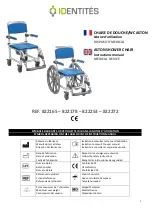
10
|
USER MANUAL
| XXL-Rehab Minimaxx – Folding Wheelchair
Warnings
During your first use of the wheelchair, perform a number of
exercises – together with your therapist or other health pro-
fessional – in order to train your ability to safely reach, lean
forward and transfer in or out of the wheelchair and become
familiar with its safety limits.
DO NOT ATTEMPT
to reach objects if you have to move
forward in the seat.
DO NOT ATTEMPT
to pick up objects from the floor if
you have to reach down between your knees.
DO NOT ATTEMPT
to reach for an object behind the
wheelchair by leaning backwards over the backrest.
DO NOT ATTEMPT
to shift your weight / sitting position
in the direction of reach, as this COULD cause the wheel-
chair to tip over.
NEVER USE
an escalator to move the wheelchair bet-
ween floors.
DO NOT ATTEMPT
to stop a moving wheelchair with
the wheel locks.
ALWAYS ENGAGE THE LOCKS
on both
wheels when transferring to or from the wheelchair.
DO NOT ATTEMPT
to negotiate ramps or slopes steeper
than 9°.
DO NOT ATTEMPT
to negotiate ramps or slopes covered
with ice, oil, or water.
DO NOT ATTEMPT
to drive over obstacles, very uneven
surfaces, etc. This could cause the wheelchair to tip over,
potentially causing personal injury.
NEVER USE
unauthorised parts, accessories, etc., as this
will void all warranties.
NEVER LIFT
the wheelchair by any detachable parts
(armrests, wheels, backrest, leg supports, etc.).
NEVER REMOVE
the anti-tippers.
DO NOT USE
the footrests as a platform when getting in
or out of the wheelchair.
DO NOT ATTEMPT
to tilt the wheelchair without assi-
stance.
NEVER STAND
on the frame of the wheelchair.
Weight training
The XXL-Rehab Minimaxx wheelchair is not designed or
tested for use during weight training. If the XXL-Rehab
Minimaxx wheelchair is used during weight training activi-
ties, Cobi Rehab shall not be liable for any personal injury
whatsoever, and all warranties will immediately be voided.
Safe operation of the XXL-Rehab Minimaxx wheelchair
Safe operation of the XXL-Rehab Minimaxx wheelchair
will require both you and your aide to be familiar with the
instructions in this manual.
Together with your therapist, analyse the techniques re-
quired to get in and out of the wheelchair, reach for objects,
etc. This will familiarise you with the “DOs” and “DON’Ts” of
using the wheelchair. It is important to practice all transfer
techniques until you feel completely safe, which will enable
you to negotiate the most common architectural obstacles.
Stability and balance
To keep the wheelchair as stable as possible at all times,
always maintain proper balance. The wheelchair is designed
to stay upright during normal everyday activities, provided
you do not move beyond the centre of gravity
Almost all activities in a wheelchair will cause the centre of
gravity to shift. Many activities will require you to reach, lean
or transfer in and out of the wheelchair. These movements
will cause a change to the normal balance, centre of gravity
and weight distribution of the wheelchair. To establish your
particular safety limits, practice all leaning, reaching and
transfer activities with the assistance of a qualified aide/
therapist before attempting active use of the wheelchair.
DO NOT LEAN
further forward than the chair’s armrests.
Make sure that the casters are pointing forward when you
lean forward. This can be ensured by first moving the chair
slightly forward and then slightly backward in a straight line.
WARNING:
Never tilt the wheelchair backwards without
assistance. Always use the anti-tippers!
Safety notes


































